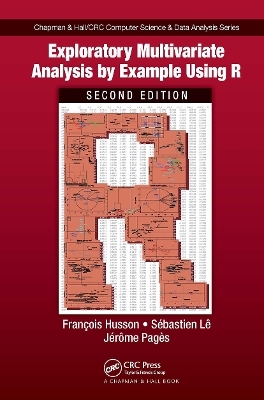
Exploratory Multivariate Analysis by Example Using R
Seiten
2020
|
2nd edition
Chapman & Hall/CRC (Verlag)
9780367658021 (ISBN)
Chapman & Hall/CRC (Verlag)
9780367658021 (ISBN)
Exploratory Multivariate Analysis by Example Using R, Second Edition focuses on four fundamental methods of multivariate exploratory data analysis that are most suitable for applications. It covers principal component analysis (PCA) when variables are quantitative, correspondence analysis (CA) and multiple correspondence analysis.
Full of real-world case studies and practical advice, Exploratory Multivariate Analysis by Example Using R, Second Edition focuses on four fundamental methods of multivariate exploratory data analysis that are most suitable for applications. It covers principal component analysis (PCA) when variables are quantitative, correspondence analysis (CA) and multiple correspondence analysis (MCA) when variables are categorical, and hierarchical cluster analysis.
The authors take a geometric point of view that provides a unified vision for exploring multivariate data tables. Within this framework, they present the principles, indicators, and ways of representing and visualising objects that are common to the exploratory methods. The authors show how to use categorical variables in a PCA context in which variables are quantitative, how to handle more than two categorical variables in a CA context in which there are originally two variables, and how to add quantitative variables in an MCA context in which variables are categorical. They also illustrate the methods using examples from various fields, with related R code accessible in the FactoMineR package developed by the authors.
Full of real-world case studies and practical advice, Exploratory Multivariate Analysis by Example Using R, Second Edition focuses on four fundamental methods of multivariate exploratory data analysis that are most suitable for applications. It covers principal component analysis (PCA) when variables are quantitative, correspondence analysis (CA) and multiple correspondence analysis (MCA) when variables are categorical, and hierarchical cluster analysis.
The authors take a geometric point of view that provides a unified vision for exploring multivariate data tables. Within this framework, they present the principles, indicators, and ways of representing and visualising objects that are common to the exploratory methods. The authors show how to use categorical variables in a PCA context in which variables are quantitative, how to handle more than two categorical variables in a CA context in which there are originally two variables, and how to add quantitative variables in an MCA context in which variables are categorical. They also illustrate the methods using examples from various fields, with related R code accessible in the FactoMineR package developed by the authors.
Francois Husson, Sebastien Le, Jérôme Pagès
Preface Principal Component Analysis (PCA) Correspondence Analysis (CA) Multiple Correspondence Analysis (MCA) Clustering Visualisation Appendix
| Erscheinungsdatum | 01.10.2020 |
|---|---|
| Reihe/Serie | Chapman & Hall/CRC Computer Science & Data Analysis |
| Sprache | englisch |
| Maße | 156 x 234 mm |
| Gewicht | 420 g |
| Themenwelt | Geisteswissenschaften ► Psychologie |
| Mathematik / Informatik ► Mathematik | |
| ISBN-13 | 9780367658021 / 9780367658021 |
| Zustand | Neuware |
| Informationen gemäß Produktsicherheitsverordnung (GPSR) | |
| Haben Sie eine Frage zum Produkt? |
Mehr entdecken
aus dem Bereich
aus dem Bereich
Der Weltbestseller
Buch | Softcover (2025)
Klett-Cotta (Verlag)
CHF 28,90
welche Berufsfelder es zu entdecken gibt und was für eine erfüllte …
Buch | Softcover (2024)
Springer (Verlag)
CHF 34,95
warum wir endlich unbequem werden müssen
Buch | Softcover (2025)
Klett-Cotta (Verlag)
CHF 25,20


